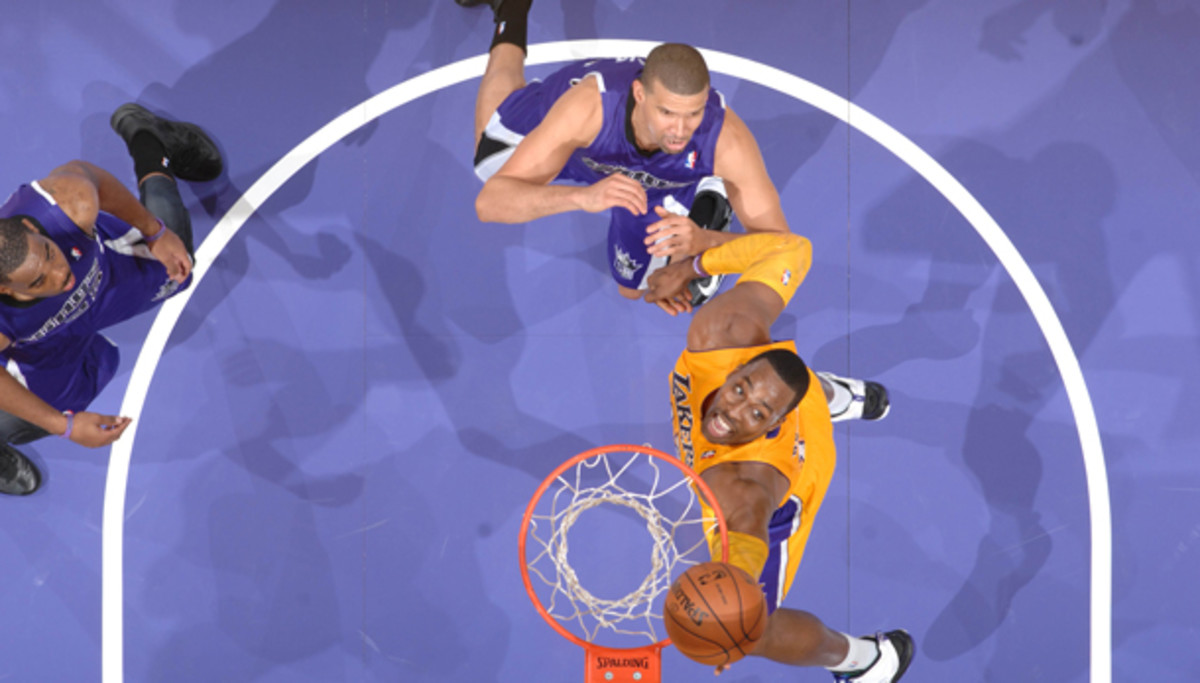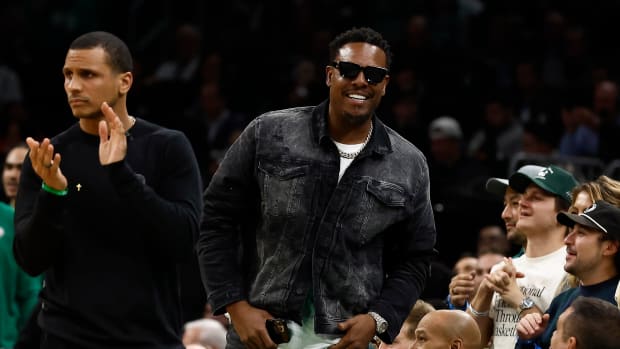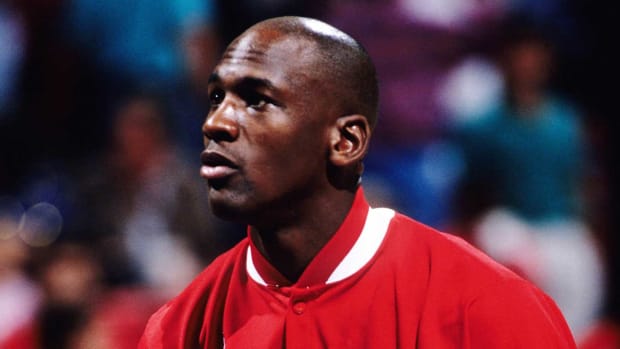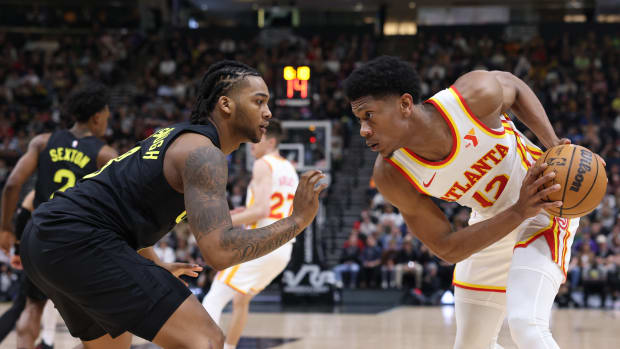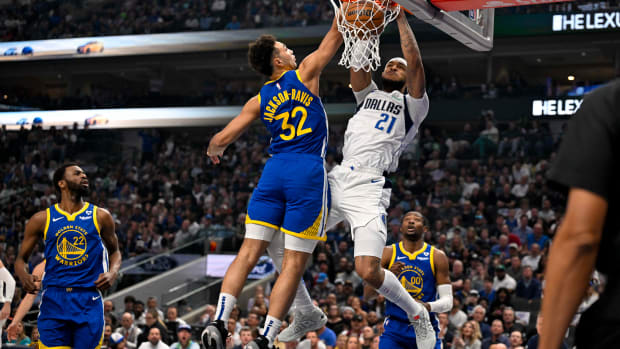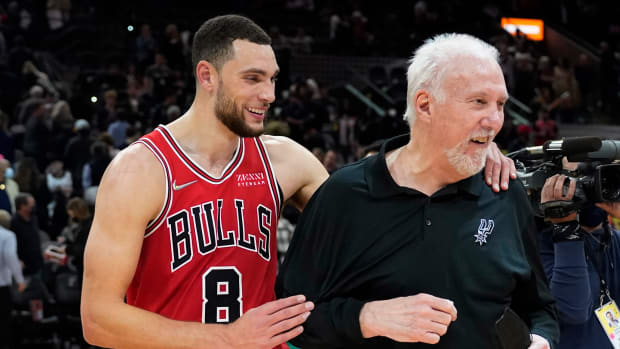Dwight Howard's Lakers debut: What did we learn?
By Ben Golliver
You have reached your limit of 4 premium articles
Register your email to get 1 more
Put aside the "It's just the preseason, it's meaningless!" maxim, at least for this one night.
The NBA's premier center took the court Sunday for the first time since April back surgery, for the first time since he left the Orlando Magic in scorched-earth style and for the first time since a four-team summer blockbuster trade shifted the league's balance of power. Dwight Howard made his debut for the Los Angeles Lakers against the Sacramento Kings at the Staples Center, scoring 19 points, grabbing 12 rebounds and blocking four shots while shooting 8-for-12 from the field in 33 minutes.
Let's take a look at what we learned about Howard and the Lakers in their 99-92 loss. Here are five takeaways from Howard's night, when he started alongside Steve Nash, Kobe Bryant, Metta World Peace and Pau Gasol against a Kings front line that included promising big man DeMarcus Cousins, 2012 lottery pick Thomas Robinson, James Johnson and reserves Jason Thompson and Chuck Hayes.
1. Howard looks healthy
The standout quality of Howard's debut was his activity level, particularly in the first half. Howard came charging out of the gate, pushed through to find his second wind midway through the first quarter and played high-intensity basketball for most of the first half. Howard worked in obvious (running the floor relentlessly off of defense rebounds) and not-so-obvious ways (regularly battling for early post position, even on possessions in which the Lakers were looking to start elsewhere). His work was rewarded in a variety of ways: numerous lob passes from teammates, intentional fouls from his Kings defenders and call after call from the officials. His was a tone-setting presence. There was no slow ramp up in his return from the injury or any apparent limitation, other than his wind, of course, which seemed to be an issue down the stretch, as everyone expected it would be.
Lakers fans should be ecstatic over what they saw in the first half. It wasn't just the pace at which Howard played; it was his ability to seamlessly shift tasks without compensating in any way for his back. He ran, shuffled, jumped, jockeyed, recovered, absorbed contact -- all with ease and in quick succession.
One standout sequence: Howard received a high lob from Bryant, going up confidently and extending to finish the play with a slam. He hustled back on defense, setting early position and then instinctively helping to block a Tyreke Evans shot attempt going toward the rim. Then, as the up-and-down play continued to the Lakers' end, Howard found himself back near the baseline, ready to receive a no-look pass left for him by a driving Bryant, forcing the Kings to foul him to prevent another free basket at the rim. In the sequence he covered 94 feet twice; left the ground to smoothly finish a play; read action and reacted quickly and precisely on defense; and took contact while creating another offensive opportunity. This is not an unusual sequence for Howard, one of the NBA's most dominant players. That he can do it from Day One this season is a pleasant surprise for the Lakers' faithful.
Dwight Howard had a promising debut with the Lakers on Sunday. (Andrew D. Bernstein/NBAE via Getty Images)
2. Howard makes his teammates better
It's so easy to think of recent Magic teams as "Howard and company." That's especially true given the benefit of hindsight (they will surely look terrible this year in their new form without him) and because of his general attitude last season ("They aren't getting me enough help, get me out of here."). In this Lakers' star-studded starting lineup, though, every other member of the quintet has a firmly established reputation independent of Howard. We, as a basketball viewing audience, know exactly who Nash, Bryant, World Peace and Gasol are as players. We've watched them play in countless All-Star Games, playoff games and championship moments. That knowledge of these four guys only helps the evaluation of how Howard will positively affect all of them.
Nash has a center with the instincts, length, power and grace to finish lob passes better than any player with whom he has played. He has a center with excellent footwork and quickness for his size; a center who can step out to set high screens, drawing a big man with him to create space in the interior; and a center who can roll hard to the basket and be perfectly content to work for weak-side rebounding position if the pass doesn't come. He has a center who is an expert at both blocking and altering shots, allowing Nash to feel a comfort factor if he gets beaten off the dribble. He has a center who is skilled at looking for quick outlet opportunities and is willing to run hard as a trail guy (at least so far). What more could a point guard reasonably want?
Bryant has a center who can do a plausible imitation of the Bryant/Shaquille O'Neal glory days, a center who sets solid picks and doesn't stand around to watch the grass grow afterward. He has a center who can create scoring opportunities for himself in isolation in the post, alleviating some of the pressure on Bryant to carry the offense. He also has a center whose ability to command attention creates more one-on-one opportunities for Bryant on the weak side when the ball reverses and whose presence down low creates space for cuts that can lead to easy buckets.
Like Bryant, World Peace will benefit from Howard's presence by getting all sorts of new daylight as teams naturally sag into the middle to pay Howard his proper attention. Unlike Bryant, though, World Peace will, game after game, find himself benefiting from the age-old "Let that guy beat us" logic. Put simply, World Peace could see hundreds of wide-open threes this season. Defensively, World Peace has a center whose elite size and agility allow him to cover both centers and big power forwards. That could save World Peace some headaches, as he should be able to stick more to bullying small forwards as opposed to shifting up to guard power forwards if opposing teams go smaller. More obviously, World Peace gets carte blanche to harass his man before, during and after the catch on the perimeter, knowing that if he gets beat back door or doesn't come up with the steal, he has plenty of help behind him. You can call that Metta World Peace of mind.
Gasol, finally, gets a truly devastating high/low partner. Though Howard isn't quite as versatile between those two roles as Gasol because he lacks a true mid-range jumper, he nevertheless is very comfortable facing up away from the hoop and he's an adept passer. On Sunday, Howard finished lob plays or high/low action from Gasol on multiple occasions; he also helped create open opportunities for Gasol by stretching the Kings' interior defense out to the free-throw line by taking up a high-post position. Over the last two seasons, Gasol often appeared frustrated and never quite found ideal chemistry with former Lakers center Andrew Bynum. If Sunday was any indication, Gasol is going to be having more fun this season than he has had in years.
3. The Lakers will be living in the bonus with Howard
This could easily get overlooked in all of the highlight slams and alley-oops. On Sunday, the Kings, especially when their smaller reserves (Hayes and Thompson) were on the court, had no choice but to foul Howard over and over. Sacramento wound up committing 28 fouls overall and L.A. finished plus-8 in free throws attempted.
Howard has always been elite at getting to the free-throw line, leading the NBA in attempts four times in his eight-year career, including each of the last two seasons. His paltry 58.8 free-throw percentage has always taken the luster off his ability to draw fouls. On this Lakers team, the presence of Bryant, Nash and Gasol, each of whom can create offense for himself and get to the foul line, makes Howard's foul-drawing skills all the more valuable. The fact that all three of those players range from excellent to solid in foul shooting -- Nash hits 90.4 percent, Bryant 83.8 and Gasol 75.2 -- just sweetens the pot even more. If there was a starting lineup built to fully counter a Hack-a-Dwight strategy, it would seem to be this one.
The Lakers on Sunday were able to play their projected starting lineup of (from left) Steve Nash, Dwight Howard, Metta World Peace, Kobe Bryant and Pau Gasol. (Mark J. Terrill/AP)
4. Howard seems to have gotten the message
It's still too early to call this one for sure, but the early returns were very positive. After spending the last 12 months making demands behind the scenes, issuing public trade requests, waffling on his contract opt-in before the trade deadline, getting cornered awkwardly in front of cameras with former coach Stan Van Gundy and then choosing to remain in Los Angeles after his surgery rather than rejoin his team, Howard rightfully accumulated a horde of doubters. He appeared to outsiders, at various times, as egotistical, self-involved, wishy-washy, tone-deaf and even childish. The entire ordeal was regrettable and some bridges were burned forever.
A new team means a new start, though, and his performance on Sunday seemed to take that to heart. He had some built-in slack available to him as a 7-footer coming off back surgery. Had he looked stiff or limited in his mobility, he wouldn't have been crucified. Had he loafed or played in an overly carefree manner, that would have been a different story. Rage would have been induced. That didn't happen. In fact, by playing hard and for 33 minutes, Howard seemed to strike a repentant tone. He looked very much like a star playing as if he had to prove himself all over again. That, perhaps more than anything else, is what the viewing public was hoping to see.
5. Howard needs to hit the treadmill and buy some stick'em
Yes, this review has been nothing but gushing to this point, so it needs to be said before closing: Howard was not flawless. His energy tank seemed drained during his fourth-quarter stretch, a period in which Sacramento outscored Los Angeles 25-20 overall and closed on a 10-0 run to come from behind to win. He was late helping from the weak side on defense, wasn't in proper rebounding position and was caught flat-footed on offense, allowing Cousins to step in and steal the ball and take it the other way for a key basket.
But Howard's conditioning has never been an issue. He's played all 82 games in five of his eight seasons and never missed significant time because of injury before his April surgery. He should be in shape, true game shape, way before that becomes a meaningful issue.
The other cause for concern on Sunday -- a little sloppiness with the ball -- is the area in which Lakers coach Mike Brown, and Howard himself, will want to see immediate improvement. Howard mishandled a few lobs, costing himself points in the process, and was stripped on isolation swipes on multiple occasions. Johnson blocked his shot from behind and Cousins picked him twice for coast-to-coast baskets. Howard also had a nice scoring opportunity on a well-timed dive snuffed out before he could elevate by pesky Kings hands when he brought the ball down to his waist. In all, he committed a team-high five turnovers. After the game, Howard, as expected, admitted to some rust.
Final Thoughts
If conditioning and rust are the only real concerns from his debut, then the night should qualify as a total success. Those two issues were going to be there, virtually no matter what.
The positive indicators, meanwhile, were overwhelming. The ball moved well, as the Lakers notched 22 assists on 33 baskets and shot nearly 50 percent from the field. Howard hit the boards, created a ton of high-percentage looks and finished a high percentage of them. Bryant was able to get his points, get to the free-throw line and show off some promising pick-and-roll action with Howard. Gasol looked comfortable and was productive (14 points, eight rebounds, five assists).






























